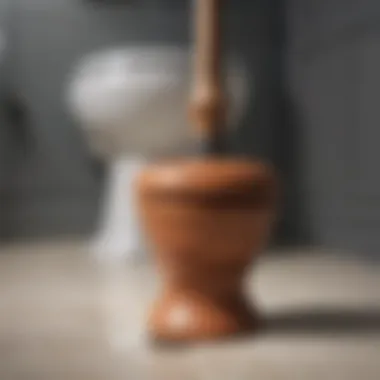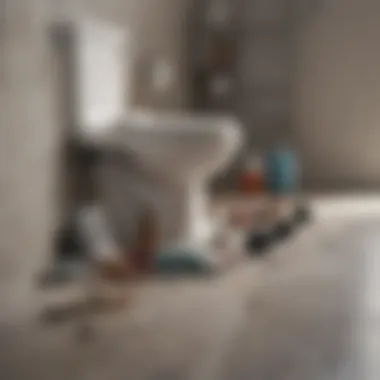Effective Techniques for Unclogging a Toilet


Intro
Toilet clogs are an inconvenience that every homeowner inevitably faces. Understanding how to effectively resolve this issue is essential. Not only does it save time, but it can also help avoid costly repairs. This article outlines the techniques that can be used for unclogging a toilet. We will highlight the various causes of clogs, the tools that can be employed, and preventive strategies to ensure your toilet remains trouble-free.
Understanding the Causes of Toilet Clogs
Before attempting to unclog a toilet, it is critical to understand what may have caused the blockage in the first place. Common culprits include:
- Excessive toilet paper: Flushing too much can easily lead to a clog.
- Foreign objects: Items like toys or sanitary products can obstruct drainage.
- Low-flush toilets: Some models may not properly clear waste, leading to backups.
Identifying the cause will aid in selecting the appropriate method for clearage.
Essential Tools for Unclogging a Toilet
A few basic tools can make unclogging a toilet more straightforward. These tools enable a homeowner to handle the task efficiently:
- Plunger: A standard household tool that uses suction to dislodge clogs.
- Toilet auger: A more specialized tool useful for deeper blockages.
- Rubber gloves: For hygiene and preventing direct contact with waste.
Having these tools readily available can make the process easier.
Techniques for Unclogging a Toilet
Using a Plunger
The simplest and often the most effective method is using a plunger. To do this, follow these steps:
- Ensure there is enough water in the bowl to cover the plunger.
- Place the plunger over the drain and create a tight seal.
- Push down and pull up forcefully several times.
- Quickly pull the plunger away from the drain to see if water clears.
If successful, the water should begin to drain. If not, you may need to try another method.
Employing a Toilet Auger
When a plunger fails, a toilet auger may be necessary. This device can reach deeper into the plumbing:
- Insert the auger into the toilet bowl until resistance is felt.
- Crank the handle to break through or retrieve the obstruction.
- Once the clog is cleared, flush the toilet to ensure proper drainage.
Chemical Drain Cleaners
While effective in certain cases, chemical drain cleaners should be used cautiously. They can be harsh on plumbing and are not recommended for persistent clogs. Always ensure to follow manufacturer guidelines and use protective gear.
Preventive Measures for Future Clogs
After experiencing a clog, it is prudent to consider preventive measures. Here are some tips to limit the chances of reruns:
- Limit toilet paper use: Only use what is necessary.
- Avoid flushing non-flushable items: Be mindful of what goes into the toilet.
- Regular maintenance: Regularly inspect plumbing to detect any potential issues before they escalate.
Remember, prevention is often more effective than dealing with a problem once it arises.
Culmination
Equipped with the right knowledge and tools, tackling a clogged toilet can be an easier task than it initially appears. By understanding potential causes, employing effective techniques, and implementing preventive measures, anyone can manage toilet issues with confidence. This knowledge not only enhances home maintenance skills but also leads to a more efficient living environment.
Foreword to Toilet Clogging
Toilet clogs are a common and often frustrating household issue. Understanding the nature of this problem is essential for any homeowner. It allows them to address clogs effectively, rather than relying solely on professional services. By familiarizing oneself with the mechanics behind toilet operation, individuals can better troubleshoot and rectify blockages. This knowledge serves not just to resolve current issues, but also to prevent future occurrences.
A clogged toilet can lead to significant inconveniences, damage, and even health risks. Therefore, recognizing early signs of clogs is key. Timely action can save time, money, and stress. This article will delve into various aspects of toilet clogs, illustrating their causes, identifying effective tools, and outlining methods for unclogging. A hands-on approach empowers individuals to confidently manage basic plumbing issues.
Understanding the Mechanics of a Toilet


The toilet functions as a complex system designed to safely remove waste and provide a hygienic environment. At its core, the toilet operates using gravity and water pressure. When the handle is pulled, it lifts a flapper, allowing water to flow from the tank into the bowl. This surge of water moves waste through the drain line. Gravity then takes over, ensuring waste travels down the pipes. Understanding this mechanism offers insight into why clogs occur and how to address them.
In modern toilets, a variety of components work in tandem—flapper, fill valve, siphon, and trap. Each plays a role in proper function. A malfunction in any part can lead to ineffective flushing or backups. Therefore, knowledge of these key components is invaluable in maintaining toilet function. Regular checks on these elements can preemptively address potential issues.
Common Causes of Toilet Clogs
Clogs can result from numerous factors. Identifying these causes is the first step in effective resolution. Some common culprits include:
- Excessive Toilet Paper: Overuse may lead to a blockage as it does not dissolve quickly.
- Foreign Objects: Items like toys, sanitary products, or wipes can get lodged in the drainage.
- Bathroom Waste: Accumulation of human waste, especially if excessive fluid is insufficient to flush it away.
- Tree Roots: In older homes, roots can infiltrate sewer lines leading to severe blockages.
Recognizing these common causes can aid in not only addressing immediate issues but also in implementing preventative strategies. With this understanding, homeowners equip themselves to handle clogs more effectively, fostering a well-maintained toilet system.
Initial Assessment of the Clog
Understanding how to assess a toilet clog is crucial for addressing the issue effectively. Initial Assessment of the Clog involves recognizing symptoms and determining the root cause of the blockage. This step is valuable because it helps avoid unnecessary actions and saves time, effort, and resources.
Correctly identifying the issue can influence the choice of tools and techniques used for unclogging. A well-informed approach presents a higher chance of successfully restoring toilet function without the need for costly professional help.
Identifying Symptoms of a Clogged Toilet
Recognizing the signs of a clogged toilet is the first step in effective problem-solving. Symptoms can vary, but there are common indicators that homeowners should watch for:
- Water Level Fluctuations: If the water level in the bowl seems higher than usual or does not drain after flushing, it often points to a clog.
- Unpleasant Odors: Foul smells emanating from the toilet can indicate a blockage, especially if remnants are unable to flow properly.
- Gurgling Sounds: Strange gurgling noises when flushing or using other fixtures nearby may signal a drain line issue related to a clog.
- Slow Draining: If water takes time to drain from the bowl or if it refills slowly, a partial clog may already be in place.
Determining the Cause of Clogs
After identifying symptoms, the next step is to understand what potentially caused the clog. Recognizing the source can significantly impact the chosen method of unclogging, leading to more efficient resolution. Multiple factors can contribute to toilet clogs:
- Excessive Toilet Paper: Flushing too much toilet paper at once can create a blockage.
- Foreign Objects: Items like toys, dental floss, or sanitary products can easily cause toilets to clog.
- Mineral Buildup: Hard water can lead to mineral accumulation over time, restricting flow.
- Damaged Pipes: Cracked or misaligned pipes may lead to restricted drainage or complete blockages.
"Identifying the root cause of the issue before proceeding is crucial in selecting the right tools and methods for an effective unclogging."
By identifying symptoms and understanding potential causes, individuals can approach the problem efficiently, thus utilizing their time and resources wisely.
Tools for Unclogging a Toilet
When facing a toilet clog, having the right tools is crucial. They ensure that homeowners can tackle the problem efficiently without costly repairs or disruptions. Using appropriate tools reduces frustration and aids in resolving the issue quickly. Understanding your options can be the difference between a DIY success and a call to a plumber.
The Essential Plunger
The plunger is a fundamental tool for dealing with most toilet clogs. Its design, featuring a rubber suction cup, utilizes hydraulic pressure to force the blockage free. The plunger's simplicity belies its effectiveness. To use it effectively, proper technique is vital. Press down slowly to create a seal, then push and pull vigorously. This will help to dislodge the clog.
Benefits of maintaining a plunger in good condition include its low cost and ease of use. It is widely available in hardware stores and can handle various clog sizes.
Alternative Tools and Equipment
Toilet Auger
A toilet auger is specialized equipment meant for deeper or tougher clogs that a plunger fails to clear. This tool features a long, flexible cable with a spiral end designed to break apart blockages lodged in the toilet trap or pipes. A toilet auger allows users to reach places a standard plunger cannot.
One key characteristic of a toilet auger is its ability to cut through solids, making it a powerful option in unclogging efforts. Although it requires more skill to operate compared to a plunger, its effectiveness makes it a popular choice for persistent clogs. Some users may find it more cumbersome to handle due to its length, but its advantages generally outweigh these disadvantages.
Drain Snake
The drain snake serves a similar purpose as the toilet auger but is more versatile. This tool can be utilized for clogs in various drains, not just the toilet. A drain snake consists of a flexible metal cable that can be fed into pipes to dislodge obstructions.
The drain snake's key characteristic is its multi-purpose nature; it is effective for multiple types of plumbing issues. It usually comes in various lengths and thicknesses, allowing users to select the best fit for specific tasks. However, some may find it difficult to use without proper guidance, which can be a drawback for less experienced homeowners.
Wet/Dry Vacuum
A wet/dry vacuum can be a valuable tool for unclogging toilets without causing a mess. This type of vacuum, designed to handle both liquid and solid waste, can suck out blockages from the toilet bowl. It can effectively remove water, which is useful if the problem is severe and requires immediate attention.


One key aspect of using a wet/dry vacuum is its efficiency in providing a clean solution. However, caution is necessary, as improper use may lead to spills or further clogs. On the flip side, a wet/dry vacuum can be a worthwhile investment due to its multiple uses around the home, from garage cleaning to yard work.
Effective Unclogging Methods
The methods utilized for unclogging a toilet play a significant role in maintaining household hygiene and functionality. Understanding these techniques not only empowers homeowners but also instills confidence in managing unexpected plumbing issues. Unclogging methods can vary widely in their execution and effectiveness, yet their relevance remains constant. Being equipped with knowledge on the most effective techniques allows individuals to address clogs quickly and efficiently, reducing the risk of damage and stress associated with plumbing failures.
Using a Plunger
The plunger is perhaps the most recognized tool for toilet unclogging. Its simplicity is its greatest asset. A standard toilet plunger consists of a rubber suction cup and a wooden or plastic handle. To use it effectively:
- Ensure a Good Seal: Place the plunger over the toilet drain, ensuring that it forms a tight seal.
- Use Firm Pressure: Push down slowly to create suction, then pull up quickly to break the seal. Repeat this action multiple times.
- Watch for Results: After several plunges, check if the water drains properly. If the clog clears, you can flush the toilet to confirm.
Tip: If you are met with resistance, avoid being overly aggressive as this can damage the toilet's internal parts.
Employing a Toilet Auger
A toilet auger is another indispensable tool when a plunger fails. It is effective for serious clogs located deep in the plumbing. A toilet auger features a long, flexible cable that can navigate the curves of the toilet trap and reach blockages beyond the reach of a plunger. Here is how to use it:
- Insert the Auger: Begin by inserting the end of the auger into the toilet bowl, aiming for the drain opening.
- Crank the Handle: Slowly rotate the handle to feed the cable deeper into the drain. The auger can break through obstructions as you feed it.
- Extract the Auger: Once resistance lessens or the cable reaches its limit, retract the auger while continuing to crank its handle.
- Flush: After removing the auger, flush the toilet to see if normal drainage resumes.
Using a Wet/Dry Vacuum Appropriately
A wet/dry vacuum is an alternative that some may overlook but can be highly effective in certain situations. Here’s a methodical way to use it:
- Preparation: Begin with the vacuum set to accept liquids. Ensure the area is dry to prevent electrical hazards.
- Seal the Toilet: Create a tight seal around the vacuum hose and the toilet drain. This may require some improvisation to ensure effective suction.
- Turn on the Vacuum: Activate the vacuum, letting it pull the clog up and out of the drain. This may work if the blockage is within reach of the hose.
- Check the Results: After several moments, turn off the vacuum and check the toilet.
- Clean Up: Dispose of any debris collected in the vacuum according to local disposal regulations.
Utilizing these methods can help maintain proper toilet function and prevent future incidents. Familiarizing oneself with these techniques ensures quicker, less stressful responses when faced with toilet clogs.
Chemical Options for Clearing Clogs
Chemical treatments can play a significant role in unclogging toilets. Using these options offers various benefits depending on the situation. It is crucial to understand the available chemicals and how they impact your plumbing and the environment. While chemical drain cleaners can provide quick results, it is important to consider their effectiveness, potential drawbacks, and safety precautions, especially for frequent users of such products.
Understanding Chemical Drain Cleaners
Chemical drain cleaners are specially formulated substances designed to dissolve clogs caused by organic materials, such as hair and grease. These cleaners come in various forms including liquids, gels, and powders, each with specific ingredients aimed at breaking down blockages effectively.
Key characteristics of chemical drain cleaners include:
- Speed: They work quickly, often within minutes, to dissolve the clog.
- Accessibility: Most are available at local stores and are easy to use for individuals without technical plumbing skills.
- Variety: Different formulas can target specific types of clogs.
However, there are concerns as well. Most chemical cleaners contain harsh substances which can damage pipes, especially older ones. Moreover, overuse can lead to more significant plumbing issues, thus, responsible usage is recommended.
Homemade Solutions for Clogs
Utilizing homemade solutions for clearing clogs can offer effective results, often with less environmental impact. These alternatives are generally more affordable and readily available at home. They are usually safer for pipes compared to commercial chemical cleaners, though they might require more time or effort.
Baking Soda and Vinegar
Baking soda and vinegar is a popular method for clog removal, recognized for its effectiveness and simplicity. When combined, baking soda reacts with vinegar to create a fizzy action that can help dislodge minor blockages.
- Key characteristic: This mixture relies on a chemical reaction rather than harsh chemicals, making it a safer option for pipes.
- Benefits: It is non-toxic, inexpensive, and often can be found in most households.
- Unique feature: The effervescence generated by the reaction may help lift clogs that are not heavily lodged.
However, this method is generally more effective for light clogs than for severe blockages. It may require repetition for tougher situations.
Dish Soap and Hot Water
The combination of dish soap and hot water can also be quite useful for clearing toilet clogs. Dish soap works as a lubricant, helping to break down sticky clogs while hot water adds heat to encourage melting.
- Key characteristic: This method is simple and utilizes common household items.
- Benefits: It can be effective for grease-related clogs, especially when regular flushing fails to clear them.
- Unique feature: The action of pouring hot water can assist in moving the clog further down the pipe.


Nonetheless, particularly stubborn clogs may not respond to this method, necessitating more aggressive techniques. Therefore, assessing the severity of the clog is crucial before choosing this solution.
In summary, while chemical options for clearing clogs can provide quick relief, there are numerous home remedies available. Being informed about the benefits and drawbacks can lead to more effective management of toilet clogs, promoting better maintenance and fewer plumbing issues in the future.
When to Call a Professional
Toilet clogs can be a relatively common annoyance in a household, but there are times when an individual should not attempt a DIY solution. Understanding when to call a professional plumber is essential for preventing further damage, saving time, and ensuring a lasting resolution. Relying on a skilled professional not only brings expertise but also access to advanced tools and techniques that might not be available at home.
Signs Indicating Professional Help is Needed
It can be difficult to assess the severity of a clog. Here are some signs that may indicate it is time to call in a professional:
- Multiple Clogs: If you notice that multiple toilets or drains in your home are clogged, it suggests a deeper issue within the plumbing system. This is often beyond the capacity of standard household methods.
- Persistent Clogs: Clogs that continue to reappear despite repeated efforts to solve can indicate a serious issue. If the blockage is not resolved after the third or fourth attempt, professional help is necessary.
- Slow Drainage: If water is draining slowly, even when the toilet is not in use, it may imply a more significant issue in the plumbing. It can signify tree roots intruding into the pipes or a buildup of debris elsewhere.
- Unpleasant Odors: Foul smells could be a signal of a serious blockage or a sewage problem. Such odors can be hazardous to health, indicating a risk of contamination.
A clogged toilet at times can be a harbinger of issues that are best left to professionals.
Cost Considerations for Professional Services
Deciding to call a professional for unclogging a toilet often comes down to weighing the benefits against the costs. Understanding what to expect in terms of pricing can help in making a more informed decision.
- Service Charges: Most plumbers charge a standard rate for their services, which typically includes a service call fee and hourly labor. The average cost for unclogging a toilet ranges between $100 to $300, depending on the severity of the clog.
- Complex Cases: If a clog is difficult to resolve, requiring advanced tools like video inspection or significant plumbing system changes, costs may rise significantly and range from $300 to $900 or more.
- Avoiding Damage Costs: While the upfront cost of hiring a professional may seem steep, this expense can actually save money in the long run. Preventing property damage due to improper handling of clogs can avoid costly repairs.
In essence, knowing when to seek professional assistance can save both time and money while ensuring a proper and safe resolution to toilet clogs.
Preventative Measures for Future Clogs
Preventing clogs is essential for maintaining a fully functioning toilet. By implementing specific strategies and habits, homeowners can mitigate the risk of future blockages. Effective preventative measures not only save time but also reduce costs related to professional repairs. As the saying goes, an ounce of prevention is worth a pound of cure.
Understanding Flushing Etiquette
Flushing etiquette is a vital aspect of toilet maintenance. Many people underestimate the impact of what they flush. Toilets are designed to handle human waste and toilet paper, not every item that may seem disposable. To avoid clogs, it is crucial to flush only appropriate materials. Items such as paper towels, feminine hygiene products, and personal care items should never be flushed. Educating family members or tenants about proper flushing can significantly decrease the likelihood of clogs.
Additionally, flushing in stages can be beneficial. If your toilet has difficulty in flushing down large amounts at once, it may help to flush in smaller increments. This allows the waste to move along the plumbing more easily and can break up potential clogs before they begin.
Regular Maintenance Tips
Regular maintenance is another key component in preventing toilet clogs. Simple tasks, if scheduled regularly, can extend the life of the toilet and ensure its efficient operation.
- Inspect the toilet regularly: Look for any signs of leaks or wear. This can help identify comfort issues before they escalate into larger problems.
- Clean the toilet bowl frequently: Build-up of minerals or debris can obstruct water flow. A regular scrub with toilet cleaner can help keep things flowing smoothly.
- Use a toilet tank cleaner: These products can help maintain cleanliness in the tank, which prevents residues from affecting flush power.
"A little regular care prevents big problems later on."
These small actions contribute to the lasting performance of the toilet. Set aside time once a month or every few months to perform these maintenance tasks. Such diligence ultimately translates to fewer clogs and enhanced toilet longevity. By maintaining awareness of flushing etiquette and regularly caring for the toilet, homeowners can significantly reduce the incidence of unwanted clogs.
Ending
Key Elements of the Culmination:
- Understanding the mechanics of toilets can guide effective unclogging efforts.
- Identifying the specific cause of a blockage plays a crucial role in finding an appropriate solution.
- Implementing regular maintenance can prevent future occurrences, saving time and unnecessary hassle.
The insight into various techniques and tools discussed serves to empower individuals, allowing them to tackle minor plumbing issues confidently. Knowing when to call a professional is just as vital, ensuring that not all problems are handled alone.
Summarizing Key Takeaways
To recap, the journey of mastering toilet unclogging encompasses several key points:
- Assessment: Begin with a proper assessment of the clog's symptoms and possible cause.
- Tools: Familiarize yourself with essential tools like plungers and toilet augers, as well as alternative methods such as wet/dry vacuums.
- Techniques: Utilizing effective techniques like plunging or employing homemade chemical solutions can resolve many common issues.
- Professional Help: Recognizing when professional interventions is necessary protects your plumbing system from further damage.
- Prevention: Regular maintenance and adherence to flushing etiquette can effectively minimize future clogs.
Arm yourself with this knowledge. It ensures you are not just reacting to issues but proactively managing your household plumbing.
Encouragement for Future Maintenance
Looking ahead, homeowners should embrace a maintenance mindset. Here are several encouragements and practices to keep in mind:
- Routine Checks: Inspect toilets regularly for any signs of minor clogs or leaks.
- Educate Household Members: Ensure everyone knows what items are safe to flush. This simple step can drastically reduce clogs.
- Invest in Tools: Having the right unclogging tools readily available can lead to quicker resolutions when clogs do occur.
- Schedule Professional Inspections: Periodic checks by a professional plumber can identify potential problems before they escalate.
By maintaining awareness and prioritizing preventive measures, the likelihood of facing a clogged toilet can be significantly reduced. Taking these proactive steps contributes to a more efficient plumbing system and enhances overall home maintenance.







